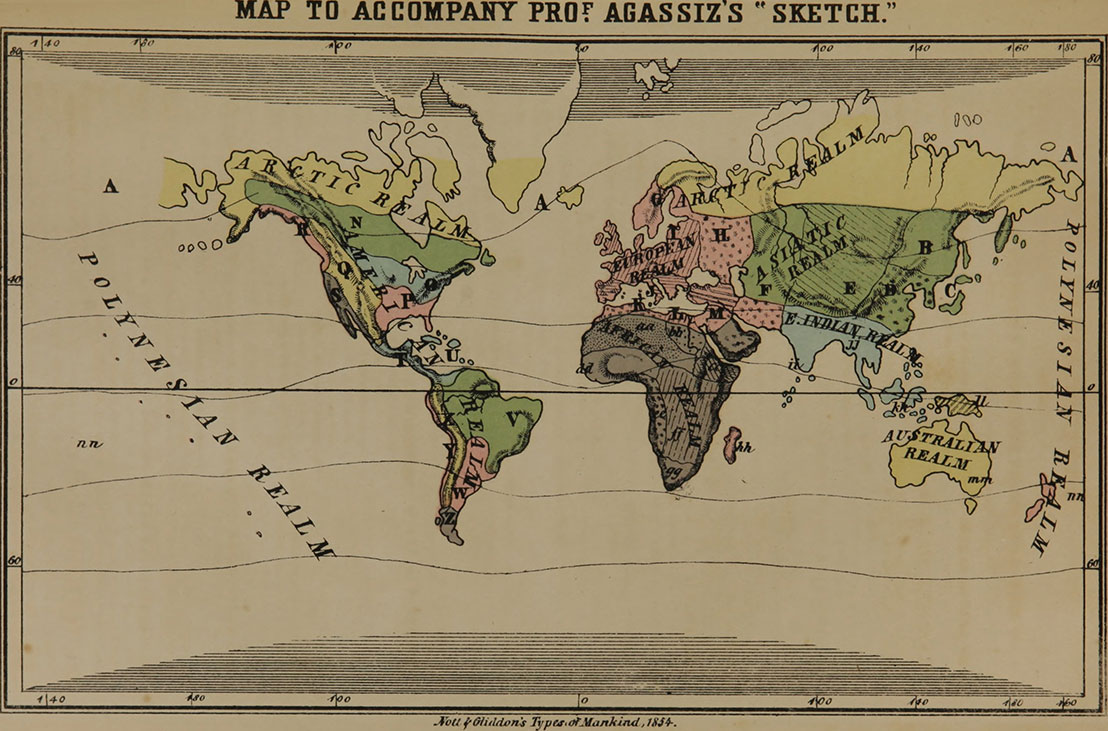This page includes information that may not reflect the current views and values of the Penn Museum. Updates on the Museum’s work towards the repatriation and burial of the Morton Collection can be found here.
Samuel George Morton (1799-1851) was a successful physician, anatomy professor, and active member of the Academy of Natural Sciences of Philadelphia. Morton is most remembered for his collection of human skulls. Although he was celebrated by his many admirers as a quintessential gentleman scholar, his life and work were more complex and conflicted. His infamous research into human races was both celebrated and rejected by some of the 19th century’s leading men of science. The following essay contextualizes Morton's life and his cranial collection in the context of America as it was before railroads and photography, decades before slavery would be abolished, the Civil War would be fought, and Darwin’s theories would forever change science and society.
Samuel George Morton (1799-1851) was a 19th century anatomist, natural historian, and member of the Academy of Natural Sciences of Philadelphia (ANSP).1 Although credited as the “father of American anthropology” and esteemed “the founder of American invertebrate paleontology,” the most detailed accounts of his life are from obituaries and memorial essays published about him soon after his death. 2 Not all of these texts agree with each other, and some are of questionable accuracy. The anonymous author of the obituary in the New York Tribune gushed about Morton’s lofty reputation among “scholars throughout the world,” expounding at length on the merits of pioneering American, as opposed to European, scientists.3 Similarly, the Charleston Medical Journal of South Carolina presented Morton as a man hailed in Europe whose research had “given to the negro his true position as an inferior race.”4 Caution is therefore warranted when reading eulogies of Morton, since they may reflect the views of the eulogists as much as they report the events of Morton’s life.
The most reliable obituaries of Morton were written by his colleagues. The first was written by his ANSP associate Charles Delucena Meigs (1792-1869), focusing on Morton’s scientific research.5 Meigs’s essay was expanded on by George Bacon Wood (1797-1879), who dealt with Morton’s medical career, and William Robertson Grant (1811-1852), who focused on Morton as an anatomy professor.6 A few years after Morton’s death, Henry Stuart Patterson (1815-1854) wrote a biographical sketch of Morton that focused on his work in physical anthropology (called “ethnology” at the time) and emphasized Morton’s support for polygeny, the notion that each human race had a separate origin.7 In 1911 a detailed account of Morton’s family and ancestry were published in a genealogical report.8
These primary source documents indicate that Morton came from a family of somewhat successful merchants. Morton was born in Philadelphia in 1799. Six months later, his 43-year old father, an Englishman born in Ireland, died during an outbreak of yellow fever. Morton’s father worked as a customs clerk for the Treasury Department at the port of Philadelphia after establishing his own, ultimately unprofitable, venture. Morton’s mother was born to a Pennsylvanian Quaker family, but converted to the Episcopal faith when she married Morton's father.9 In 1899, the widowed Mrs. Morton and her children moved in with relatives in New York state, where she married a Quaker. Morton’s mother and stepfather moved back to the Philadelphia area circa 1813.10 Although Morton was a lifelong Episcopalian, he was educated at Quaker schools near New York City, West Chester, Pennsylvania, and Burlington, New Jersey. At the age of sixteen, he became an apprentice at a mercantile house in Philadelphia, a job he disliked.11 Morton was the youngest of nine brothers and sisters, but only he and one sister survived to adulthood.12
In 1817, Morton’s mother died after a protracted illness, and the eighteen year old Morton enrolled in a private anatomical school operated by Joseph Parrish (1779-1840), a physician who had attended Morton’s sick mother.13 One of Morton’s instructors was Richard Harlan (1796-1842), a physician and natural historian who, at the age of 19, was elected to the ANSP. Harlan’s Fauna Americana: Being a Description of the Mammiferous Animals Inhabiting North America (1825), was the first systematic presentation of the mammals of North America and had a significant influence on Morton’s later research.14 After coursework at Parrish’s school, Morton enrolled at the University of Pennsylvania Medical School, earning his MD in 1820.15 In that same year, Harlan arranged for Morton to become a member of the ANSP.16
Later in 1820, Morton sailed to Clonmel, Ireland, to visit his uncle James Morton (1762-1840), a successful English merchant. James was impressed with Morton and arranged for him to attend medical school at the University of Edinburg, which was much better regarded than any American medical school at the time.17 There, Morton attended lectures by the famed professor Robert Jameson (1744-1854), whose collection of animal and minerals specimens would serve as the foundation as the Royal Scottish Museum.18 Morton also befriended Thomas Hodgkin (1798-1866), a devout Quaker abolitionist.19 In 1821, the two men traveled to Paris together to receive specialized medical training.20
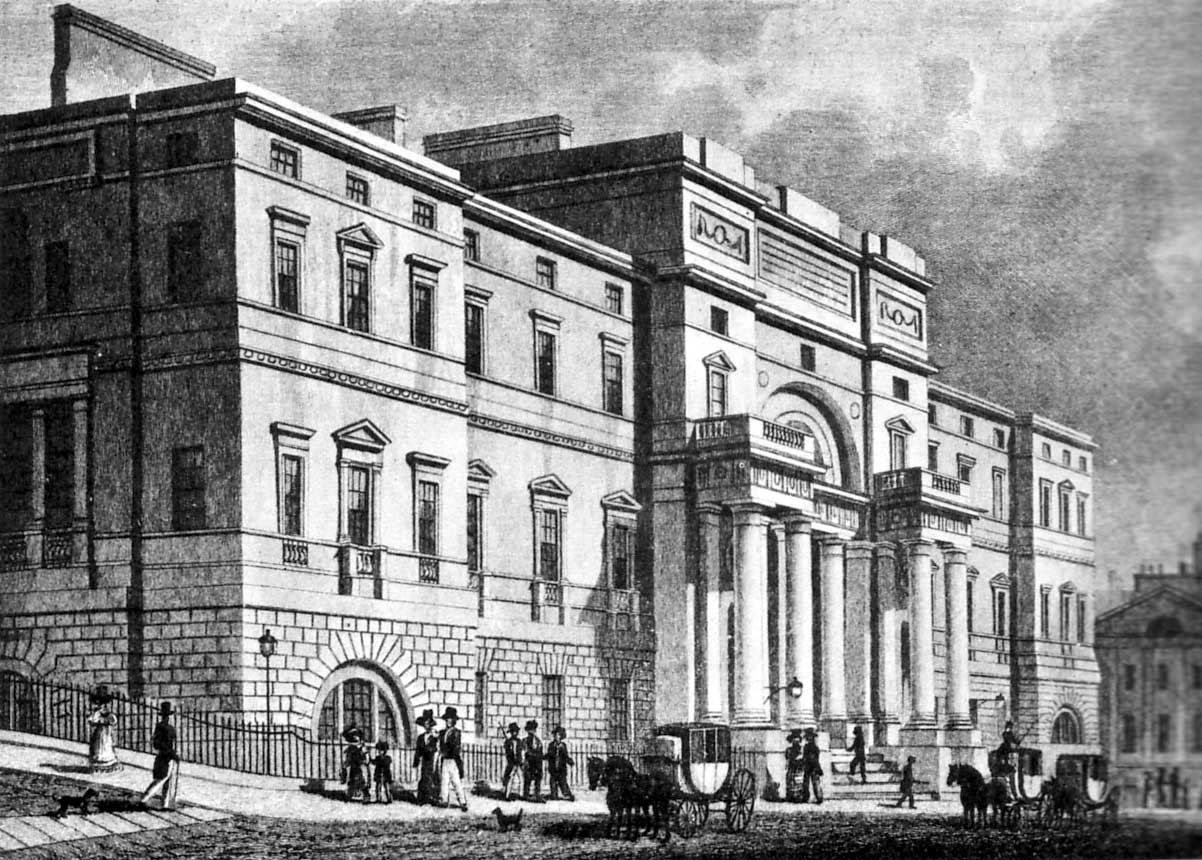
During Morton’s stay in Europe he was twice (circa 1820 and 1821) struck by attacks of a nearly fatal illness, possibly liver disease, which left him weak and sickly for the rest of his life.23 Wood stated that from then on, Morton suffered from “excruciating attacks of sick headache” so severe they would “confine him for a time to his bed.”24 This experience may have influenced his doctoral thesis, which was a review of the existing medical literature on the nature of pain. Morton also noted that “the origin of all the varieties of character are congenital, and those differences for a greater part must be ascribed to the structure of the brain.”25 Thus, from early in career, Morton asserted that the structure of the brain determined a person’s mental attributes and that brain structure was inherited. Although many of Morton contemporaries also held such “hereditarian” views, many leading scholars, like his friend Harlan, were “environmentalists,” who held that humans were primarily shaped by their environment. Late in life, Morton commented that he had been educated to accept environmentalism, but grew to reject it because it seemed implausible that “chance, chance alone has caused all the physical disparity among men, from the noblest Caucasian form to the most degraded Australian and Hottentot.”26
Morton was awarded his second medical degree from the University of Edinburgh in the summer of 1823. By 1824, he had returned to Philadelphia.28 In 1825, Morton authored his first “scientific, published essay,” entitled “Observations on Cornine,” which appeared in the Philadelphia Journal of the Medical and Physical Sciences.29 Morton was reporting on the use of a plant extract called cornine to reduce fever. After Morton’s death, Wood noted that the effectiveness of cornine for this purpose was “at best doubtful.”30
With some effort, Morton established a successful medical practice in Philadelphia.31 In 1826, he married Rebecca Pearsall (1805-1864), an Episcopalian whose Quaker grandfather, Isaac Collins (1746-1817), was a vocal abolitionist and a successful printer.32 Morton and his wife raised nine children, all of whom survived to adulthood. One of his sons became a successful Philadelphia ophthalmologist, another was ordained as an Episcopalian priest, and a third was a Union officer killed in the Civil War.33 Dr. and Mrs. Morton were also fond of hosting a regular “Sunday evening reception… for the purpose of bringing together his scientific friends” and visiting scholars from abroad.34

During 1827, Morton became an officer in the ANSP, serving as its recording secretary until 1829. The late 1820s were a challenging time for the ANSP, especially after its brilliant but eccentric second president and financial patron, William Maclure (1763-1840), moved to a newly settled, short-lived utopian community in Ohio.35 However, the ANSP was saved by its fourth president, George Ord (1781-1866), assisted by Harlan and Morton. This trio “eliminated amateurish, descriptive work and insisted upon a higher level of scientific professionalism though specialization.”36 From that point on, Morton played a key administrative role in the ANSP, serving as its curator (1830-1833), corresponding secretary (1831- c.1836), vice-president (c.1841- c.1848) and president (1849-1851)37 Morton’s youthful experiences in the world of commerce may well have given him practical administrative skills useful in the budgeting, staffing, and managing an organization like the ANSP.38
Meigs wrote that young Morton “preferred history, in the reading of which he took extravagant delight” but did not acquire “any strong bias for mathematics.”39 In 1827, Morton authored his first two geological publications: the “Analysis of Tabular Spar from Bucks County, Pennsylvania” and the “Description of the New Species of Ostrea.” Both were published in the Journal of the Academy of Natural Sciences, Philadelphia.40 Meigs listed forty-four “papers and notices” penned by Morton between 1825 and 1849, about forty of which were published in the ANSP’s journal, later called The Proceedings of the ANSP. Over half of these “papers and notices” are less than two pages long, and some were quite inconsequential, such as his “A Living Albino Raccoon.” In this notice, he simply remarked that he had been given a live albino raccoon that somewhat resembled a bear, which “forcibly reminds the observer of the fact that Linnaeus placed the Raccoon in his genus Ursus.”41 Morton was also an illustrator. In 1827, he illustrated the genitals of a gibbon (then referred to an “orang outang”) featured in Harlan’s Description of an hermaphrodite Orang Outang lately living in Philadelphia.42 Morton later illustrated his own invertebrate paleontology publications.43
Morton did make some significant contributions to the natural sciences at a time when such research was only beginning in the United States. Unlike some naturalists, the sickly Morton did not travel extensively. Aside from his university days in Europe, he only went on one major excursion in 1834, spending time in Barbados and visiting some other Caribbean isles on route.44 However, Morton had full access to the ANSP collections, which in the year following his death included over 13,000 books and some 148,000 specimens.45 Much of Morton’s research concerned specimens delivered to him in Philadelphia from overseas ports or the American frontier.46
Morton cemented his reputation as a paleontologist after describing fossils unearthed in the digging of the Chesapeake and Delaware Canal.47 Later, he was selected to describe the fossils that Lewis and Clark brought back with them from the American West.48 Morton’s studies of fossils in Cretaceous sand and marl layers in New Jersey showed their relation to chalk regions of Europe. A century later, such research would be used to document continental drift.49 Morton is also credited with being the first to describe the West African pygmy hippopotamus species (Choeropsis liberiensis).50 Morton had been shipped two pygmy hippopotamus skulls (along with human skulls) from a colonial physician stationed in Liberia who had seen the animals and noted their marked differences from the common hippopotamus.51
By all accounts, Morton was a well-liked, reserved, and polite man.52 Meigs called him “earnest and always to be depended on” while Patterson noted he possessed “in a remarkable degree, the faculty of imparting upon others his own enthusiasm” which led to his success in “enlisting… numerous collaborators.”53 Such interpersonal skills likely served him well in administering the ANSP, and in advancing his career as an anatomy professor and a physician. In 1829, Morton was appointed as one of the physicians to the Philadelphia Almshouse.54 The following year he became a “medical teacher” at the newly founded Philadelphia Association for Medical Instruction, where one of his fellow instructors was his former professor, Dr. Parrish. In 1835, Morton published a 180-page medical book on pulmonary consumption, based on his experiences treating that malady at the Almshouse.55 In 1835 and 1837, he edited the first and second editions, respectively, of Mackintosh’s Principles of Pathology.56 From 1839 to 1843, Morton was a professor of anatomy at the Pennsylvania Medical College.57 In 1845, he was elected a fellow of the College of Physicians of Philadelphia and three years later, he authored his own anatomy textbook, Human Anatomy, Special, General and Microscopic.58
According to Morton, he began to collect human skulls in 1830. He claimed that he did so because he was preparing a lecture on “the form of the skull as seen in the five races of men,” but determined that such skulls “could neither be bought nor borrowed.”59 In 1849, he reported that he had acquired 867 human skulls through “much time toil and expense.”60 However, Wood recalled seeing skulls in Morton’s office not long after Morton began his medical practice.61 Thus, it appears most likely that Morton’s interest in skulls may have been inspired by Harlan, who also collected skulls, and by 1825 had acquired a “Mongolian… from Kamstachka.”62
In 1838, Harlan advertised that he was offering to sell his collection of “700 specimens,” which included forty-six human skulls, each of which of interest due to “its individual history or the race of men to which it belonged.”63 Unfortunately, the collection was largely destroyed in a fire in 1839.64 Ten years later, Harlan moved to New Orleans, where he was struck with a sudden “apoplexy” and died.65 Harlan, who had a bad temper and a caustic personality, had alienated so many of his former friends that little was written about him after his death. As a result, he is not nearly as well-known to modern historians as Morton.66
In 1838, Morton began his intensive research on his skull collection, but he did not work alone. The seventy-two lithographs of skulls included in his first craniological work, Crania Americana (1839), were completed by his wife’s cousin, John Collins (1814-1902), a successful Philadelphia printer.67 These skulls were drawn to scale on large sheets of paper, so each skull could be seen as if in life.68 In measuring the skulls, Morton was assisted by John S. Phillips (1800-1876), a wealthy mill owner and inventor active in the ANSP.69 Phillips constructed a device that could, so Morton claimed, accurately and consistently measure the volume of a skull’s braincase, called the “internal cranial capacity.”70
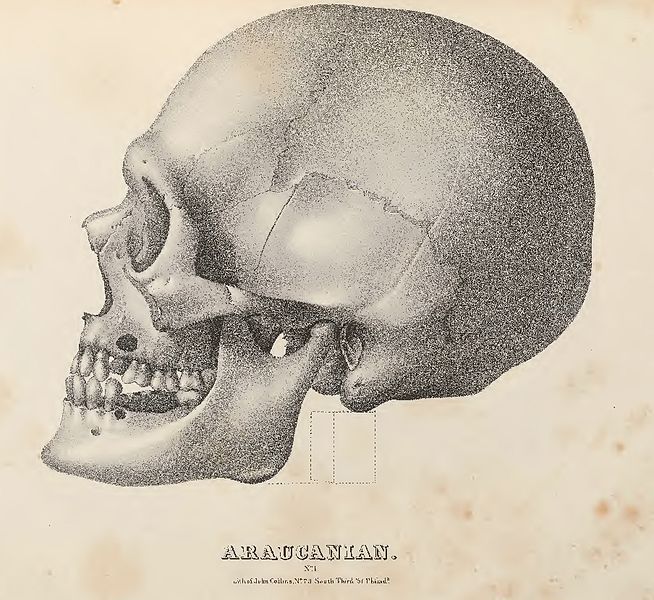
Morton had initially requested the services of a Philadelphia physician and phrenologist Joseph C. Turnpenny (c.1806–c.1838) in conducting phrenological measurements of his skulls.72 When Turnpenny died unexpectedly, Morton contacted George Combe (1788-1858), a Scottish lawyer and bestselling author of phrenology books who was visiting the United States on a lecture tour.73 Furthermore, Combe’s 1824 book, Elements of Phrenology, presented tables of skull measurements and so he had experience in this area.74 By 1839, Morton had completed his cranial research and published his results in Crania Americana: or a Comparative View of the Skulls of the Various Aboriginal Nations of North and South America. In this book there was an appendix written by Combe on the topic of phrenology.75
Crania Americana did not sell well when it was first released, which was a problem for Morton because the lavishly illustrated book was expensive to make.76 Combe used his contacts in Europe to increase sales, but the publication was never profitable. A number of the books were lost in a shipwreck and Morton considered selling his collection to make up for the financial loss. However, soon after, Morton’s wealthily uncle James died, leaving Morton enough of an inheritance to erase his debts and keep the collection.77 (After Morton died, a number of his admirers bought the collection for $4,000 from Morton’s widow and donated it to the ANSP.)78
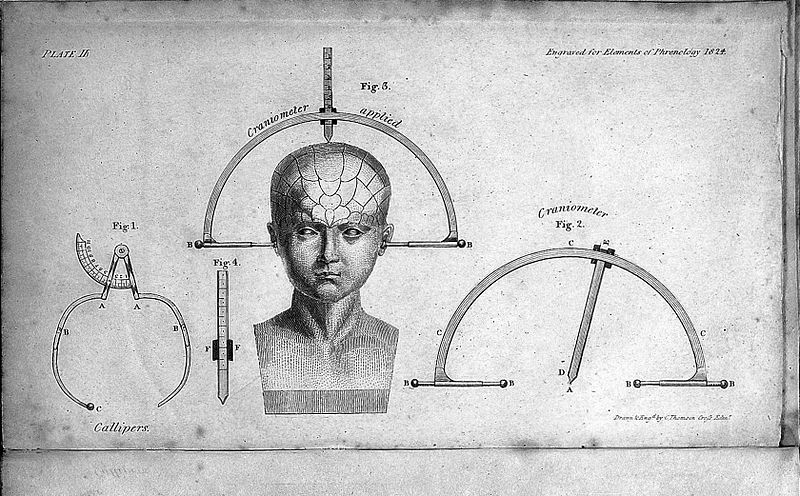
Crania Americana established Morton’s celebrity as a leading ethnologist and craniologist of his day.80 Some modern historians have focused narrowly on the significance of the cranial measurements published within Crania Americana, but Morton’s interests in skulls concerned more than just measurement.81 In the introduction of Crania Americana, Morton explained that he wrote the book to address a number of key topics including the unusual shape of certain Native American skulls, and the evidence that Native Americans were composed of a number of unique and distinct races.82 He asserted that that Native Americans were not related to far eastern Siberians, but instead were a distinct race which originated in the Americas, not Asia.83 In 1842, Morton repeated this assertion in a public lecture, the text of which was published in 1844 as An Inquiry into the Distinctive Characteristics of the Aboriginal Race of America.84 Within Crania Americana, Morton also made the incorrect assertion that some Native Americans had naturally elongated heads, but he “took occasion to renounce” that claim in 1840 and again in 1844.85
Furthermore, Morton argued that Native Americans consisted of one race consisting of two distinct “Great families,” one of which was mentally superior to the other. He labeled the superior family the “Toltecan Nations,” including the Aztecs, Inca, and the Mound Builder Indians who once flourished in the Mississippi Valley. All other Native Americans were simply designated as “Barbarous Tribes.” According to Morton, a superior race of pyramid-building “Toltecans” had established communities in southern Mexico, Peru, and North America, but eventually withdrew from North America.88 He continued to argue in favor of this two-fold division for the rest of his career.89
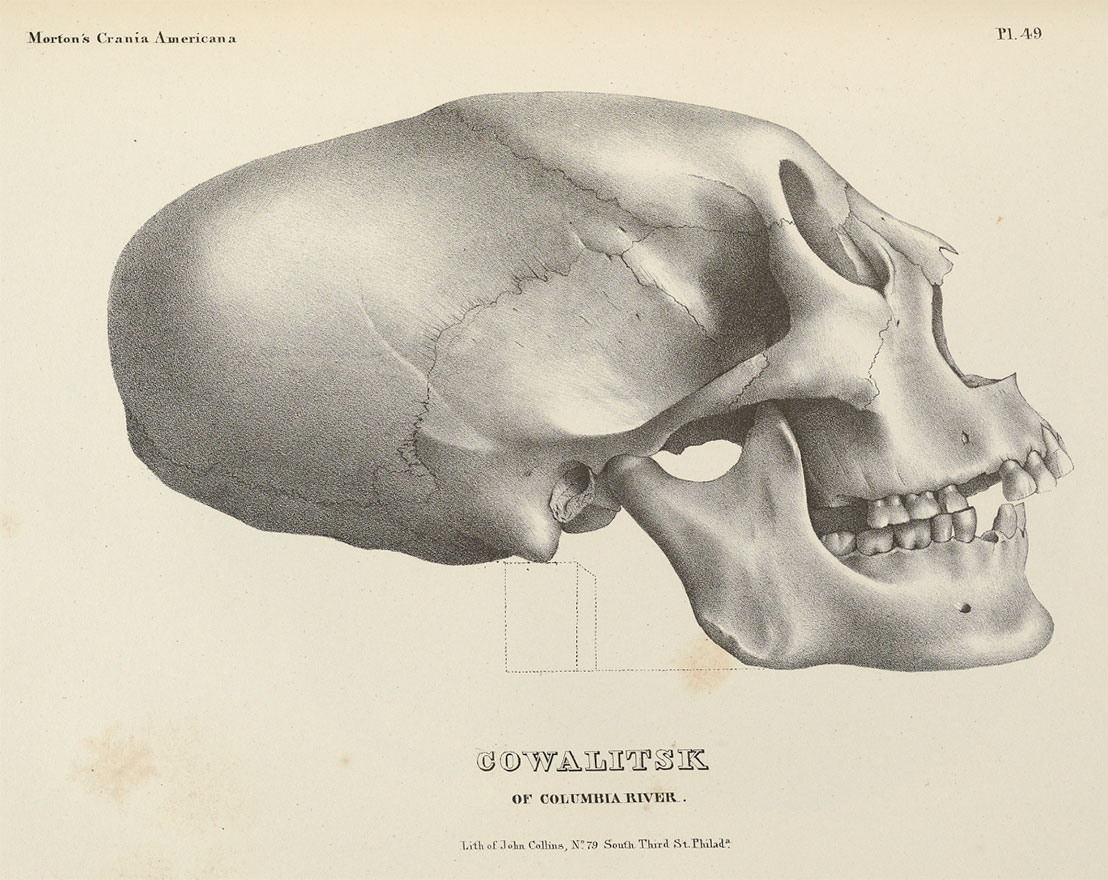
Morton’s eulogist correctly noted that Crania Americana was well received by a number of leading scholars.90 Meigs reported that “Upon its publication, it was welcomed in the American Journal of Sciences and Art, as the most important, extensive, and valuable contribution to the Natural History of Man which has yet appeared on the American Continent.” Meigs also noted that "the most flattering encomiums upon Dr. Morton's labors" were published in journals such as “The Medico-Chirurgical Review, the Western Journal, the British and Foreign Medical Review, the Journal of the Royal Geographical Society, the Eclectic Journal, and the Edinburgh Medical and Surgical Journal.”91
However, Crania Americana was also critiqued by a number of leading scholars. Jameson, Morton’s former Edinburgh professor, lambasted Morton’s cranial capacity table as a kind of “ridiculous blunder.” Jameson added, “What strikes me in Dr. Morton’s tables completely invalidates his conclusions, – he has not distinguished male and female crania.”92 The British craniologist Joseph Davis (1801-1881) also faulted Morton for failing to “distinguish the skulls of women from those of men when calculating averages.”93 In 1852, the Scottish-Canadian, archaeologist Daniel Wilson (1816-1892) examined Morton’s skull collection, and concluded that Morton’s classification of Native Americans into Toltecan and Barbarous groups was “arbitrary, indefinite, and valueless.”94 By 1911, Aleš Hrdlička (1869-1943), one of the United States' most important 20th century physical anthropologists, noted that Morton’s “measurements and observations are only of very little value today.”95
In many respects, Morton’s 1839 Crania Americana, which was primarily an anatomical and ethnological survey of the tribal nations of North America, was an expansion of Harlan’s Fauna Americana. In 1844, Morton published a study of Egyptian skulls, which was an expansion of a 1797 study of mummies published by German anatomist and craniologist Johann Friedrich Blumenbach (1752-1840).96 Morton entitled this work Crania Aegyptiaca or, Observations on Egyptian Ethnography, Derived from Anatomy, History and the Monuments. Within this book, Morton presented an examination of Egyptian skulls and compared them with the ways that heads were depicted in ancient Egyptian art.97
Morton conducted this study after Egyptian skulls were shipped to him from Egypt by George Gliddon (1809-1857).98 Gliddon was an Englishman who spent much of his early life in Alexandria, Egypt, where his father conducted business. Eventually, Gliddon toured Europe and America giving lectures on Egyptology.99 Gliddon’s work was noticed by Morton, who requested that Gliddon ship him the skulls of ancient Egyptians. In this endeavor Gliddon succeeded, eventually shipping one hundred skulls and mummified heads to Morton.100 Gliddon and Morton eventually became friends, and Morton dedicated Crania Aegyptiaca to Gliddon. 101
On the first page of Crania Aegyptiaca, Morton explained that the purpose of his research was to identify the races of ancient Egypt, and determine who built all of Egypt’s monuments.102 Crania Aegyptiaca touched on another important question of the day: How old was ancient Egypt? This issue had already been addressed by scholars like Ippolito Rosellini (1800-1843), Jean-François Champollion (1790-1832), and Archbishop Nicholas Wiseman (1802–1865).103 However, this exercise turned out to be problematic from a theological standpoint. The detailed records discovered in Egypt pointed to a very old age for Egyptian civilization, perhaps older than the date that Biblical scholars had calculated for the creation of the Earth.104 Did this mean the Bible was mistaken?
The findings Morton presented in Crania Aegyptiaca were that Egypt was founded at some long ago date, but after the Great Flood of Noah. Furthermore, Morton argued that the ancient skulls in his collection came from a number of existing races. Morton had already made such a statement in Crania Americana in 1839. There, he wrote that “recent discoveries in Egypt” had shown “beyond all question” that the “Caucasian and Negro races” were “perfectly distinct” in Egypt 3,000 years ago just “as they are now.” He asserted that the alteration of racial traits by “external causes” was a “physical impossibility.”105
Thus it was Morton’s long-standing assertion that racial divisions of humanity had been in place since ancient Egypt, without changing since then. He also concluded that ancient Egypt was “originally peopled by a branch of the Caucasian race,” who ruled as the “Kings of Egypt.” He further asserted that “Negroes were numerous in Egypt, but their social position in ancient times was the same that it now is, that of servants and slaves.”106 Morton also illustrated Crania Aegyptiaca with lithographs of skulls, although not as large as the ones from Crania Americana. Morton’s financial difficulty with Crania Americana may have led him to reduce production costs with the more modest Crania Aegyptiaca.
During his final years, Morton argued that there were multiple species of humanity, and that mixed-race people were “hybrids.” In April 1851, just a month before he died, Morton gave a presentation to the ANSP in which he “offered some remarks on the infrequency of mixed offspring between the European and Australian races.” In this talk, based on a paper he published in 1847, Morton presented an Australian census table which listed the number of mixed-race children in various districts.107 Morton’s lecture concluded that the reported lack of mixed-race offspring in Australia was due to the “disparity of primordial organization.” His argument was that Europeans and Indigenous Australians were, like different species, so anatomically different that they could not effectively interbreed. Morton wrote that “Perhaps no two human races are more remote from each other than the European and Australian; and where such extremes are blended, reason and analogy lead us to expect only a limited fertility.”108
Just as Crania Aegyptiaca and Crania Americana were expanded from the research of others, so Morton’s research into human hybridity was based on the writings of Josiah Nott (1804-1873), an Alabama surgeon and anatomy professor who was trained in France and made major contributions to the study of yellow fever.109 Nott was a slave owner and ardent supporter of the Confederacy.110 In 1843, Nott published his first article on race in the American Journal of Medical Sciences with the dramatic title, “The Mulatto a Hybrid – Probable Extinction of the Two Races if the Whites and Blacks are Allowed to Intermarry.”111 In it, he used information from the US census to argue that differing races of humans were in fact different species, but they could interbreed. Nott also noted that mulattoes were more susceptible to disease, and that mixed-race women were, “bad breeders and bad nurses.”112 After reading this and other of Nott’s race-supremacist articles, Morton wrote Nott a letter hailing the “triumphant manner” in which Nott presented his case for white supremacy and polygeny.113 A strong friendship and scholarly collaboration followed.114 Nott also became friends with Gliddon, and the two went on to publish together.115
Morton’s publications on race indicate that he was a polygenist, a term describing those scholars who asserted that human races had separate origins. Unlike his more bombastic colleagues Nott and Gliddon, the quiet and polite Morton had an “extreme dislike of controversy” which “made him particularly guarded in his statements.”116 However, in a private letter written to Nott in 1850, Morton wrote that he opposed the “absurd postulate, that one race can be transmuted into another” and he avowed his belief in a “plurality of origins for the human species.” Morton further wrote that he had taken this position “though more cautiously worded” in Crania Americana of 1839, but at the time muted his assertions “not because I doubted the truth of my opinions, but because I feared they would lead to some controversy with the clergy.”117 Morton’s attempt at subtlety did not succeed. Citing personal letters, Patterson convincingly documented that Morton had been a supporter of polygeny as far back at the 1830s, but never went public because he wished to avoid the religious controversy such a stance would arouse.118 Over time it became clear to his peers that Morton was a polygenist. He lost support from anti-race supremacists scholars like Alexander von Humboldt (1769-1859) and grew away from his old friend Thomas Hodgkin, who had become a leading advocate for the rights of “aboriginal” peoples.119
Morton’s most vocal critic was John Bachman (1790-1874), a Lutheran minister and expert field biologist who supported slavery but contended that all humans shared a common origin.120 In 1850, Bachman authored some lengthy refutations of polygeny and, more specifically, Morton’s research.121 In one such publication, Bachman included a copy of Morton’s 1849 table of brain size of “the various races and families of men” along with the comment that the table was evidence of the “utter futility of any attempt to divide the races of men into different species from the size of the brain."122 Morton then published a counter argument. This literary feud came to an end when Morton suddenly died, and out of respect, Bachman let the issue drop.123 Morton’s death was not, however, totally unexpected. In December of 1848, he had suffered an attack of “severe pleurisy and pericarditis” during which his left lung collapsed.124 According to Wood, the death of one of Morton’s sons in 1850 also took a toll on his health.125 During the last few years of his life, Morton was so ill that he hardly left his home, except for his ANSP office.126
Morton’s publications on race and craniology continued to be of interest in the decades following his death. In 1854, Morton’s colleagues, Nott and Gliddon, published their best-selling book, Types of Mankind which advocated for race-supremacy, based partly on Morton’s craniological research.127 Types of Mankind also included large passages from “Elements of Ethnology,” an incomplete and unpublished manuscript Morton authored before he died. In these texts, Morton unequivocally expressed his support for polygeny saying that after “twenty years of observation and reflection” the only explanation he could find to explain human racial diversity was “an original plurality of races.”128
After his death, Morton’s research into race, craniology, and hybridity was warmly received by some scholars like Charles Smith (1776-1859), Paul Broca (1824-1880), and Louis Agassiz (1807-1873).129 However, Morton’s research was criticized as being of poor quality by Lewis Morgan (1818-1881), Franz Ignaz Pruner (1808-1882), Joseph-Arthur Gobineau (1816-1882), and Karl Vogt (1817-1895).130 Perhaps Morton’s best-known critic was Charles Darwin (1809-1882). In 1847, he wrote a letter to Charles Lyell (1797-1875), warning him about the poor quality of Morton’s writings on animal hybridity.131 Darwin wrote that he was:
“…glad to have seen Dr. Morton’s article: my opinion, of it, as you ask for it, is that it is in main part, a merely tabulated compilation from Griffith’s Cuvier, with a few other facts interpolated. He is, I think, too credulous; but it is a pretty good compilation: his worse fault is that he has not gone to his original source… there is a want of exactness in the manner Morton gives the facts… In conclusion, therefore, I do not think Dr. Morton a safe man to quote from.”132
